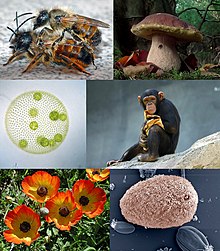Eukaryote
(Àtúnjúwe láti Ẹ̀ùkáríọ́tì)
| Ẹ̀ùkáríọ́tì Eukaryote | |
|---|---|

| |
| Eukaryotes and some examples of their diversity – clockwise from top left: Red mason bee, Boletus edulis, chimpanzee, Isotricha intestinalis, Ranunculus asiaticus, and Volvox carteri | |
| Ìṣètò onísáyẹ́nsì [ e ] | |
| Àjákálẹ̀: | Eukaryota (Chatton, 1925) Whittaker & Margulis, 1978 |
| Supergroups[2] and kingdoms | |
Eukaryotic organisms that cannot be classified under the kingdoms Plantae, Animalia or Fungi are sometimes grouped in the kingdom Protista. | |
Ẹ̀ùkáríọ́tì tabi ahamo eukarioti je awon ohun elemin[3] ti awon ahamo ara won ni koroonu ninu. Eyi lo ya won soto si pròkáríọ́tì, ti ahamo won ko ni koroonu. [4]
Itokasi[àtúnṣe | àtúnṣe àmìọ̀rọ̀]
- ↑ "Tracing back EFL gene evolution in the cryptomonads-haptophytes assemblage: separate origins of EFL genes in haptophytes, photosynthetic cryptomonads, and goniomonads". Gene 441 (1–2): 126–31. July 2009. doi:10.1016/j.gene.2008.05.010. PMID 18585873.
- ↑ "The revised classification of eukaryotes". The Journal of Eukaryotic Microbiology 59 (5): 429–93. September 2012. doi:10.1111/j.1550-7408.2012.00644.x. PMC 3483872. PMID 23020233. Archived from the original on 16 June 2016. https://web.archive.org/web/20160616160800/http://www.paru.cas.cz/docs/documents/93-Adl-JEM-2012.pdf. Retrieved 26 May 2020.
- ↑ "Eukaryote". ScienceDaily. 2018-05-19. Retrieved 2018-05-20.
- ↑ "Eukaryote - biology". Encyclopedia Britannica. 2018-05-10. Retrieved 2018-05-20.
